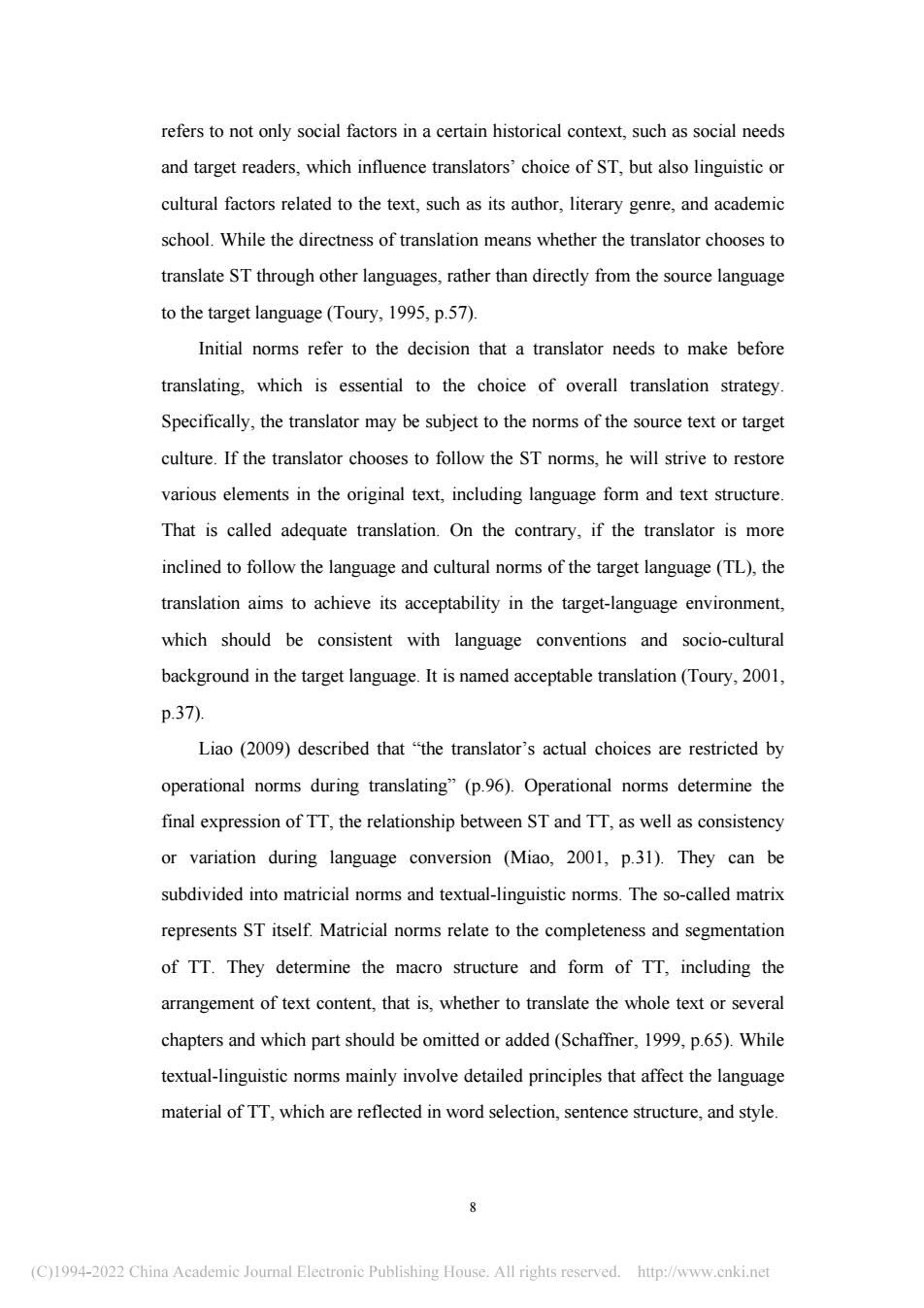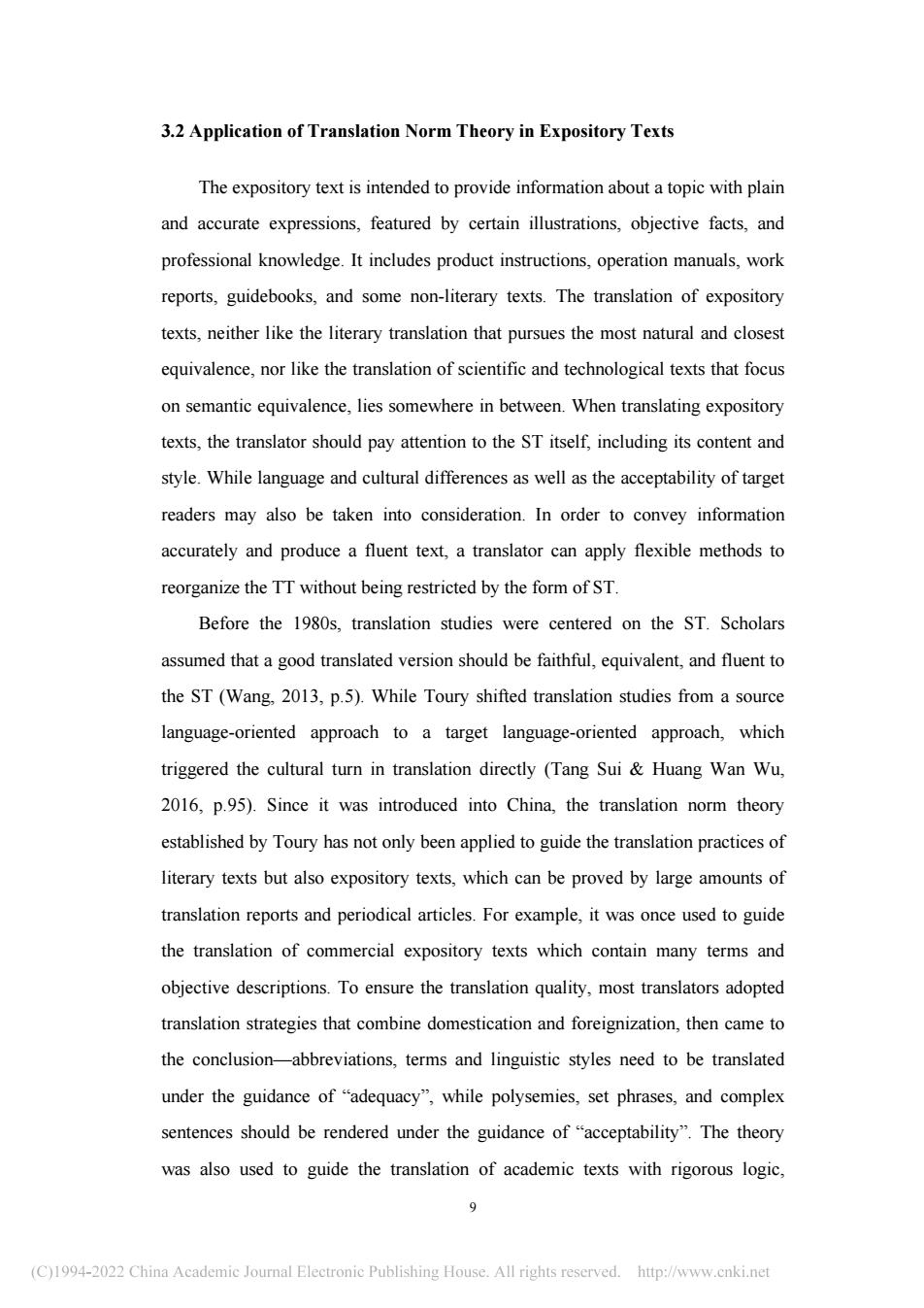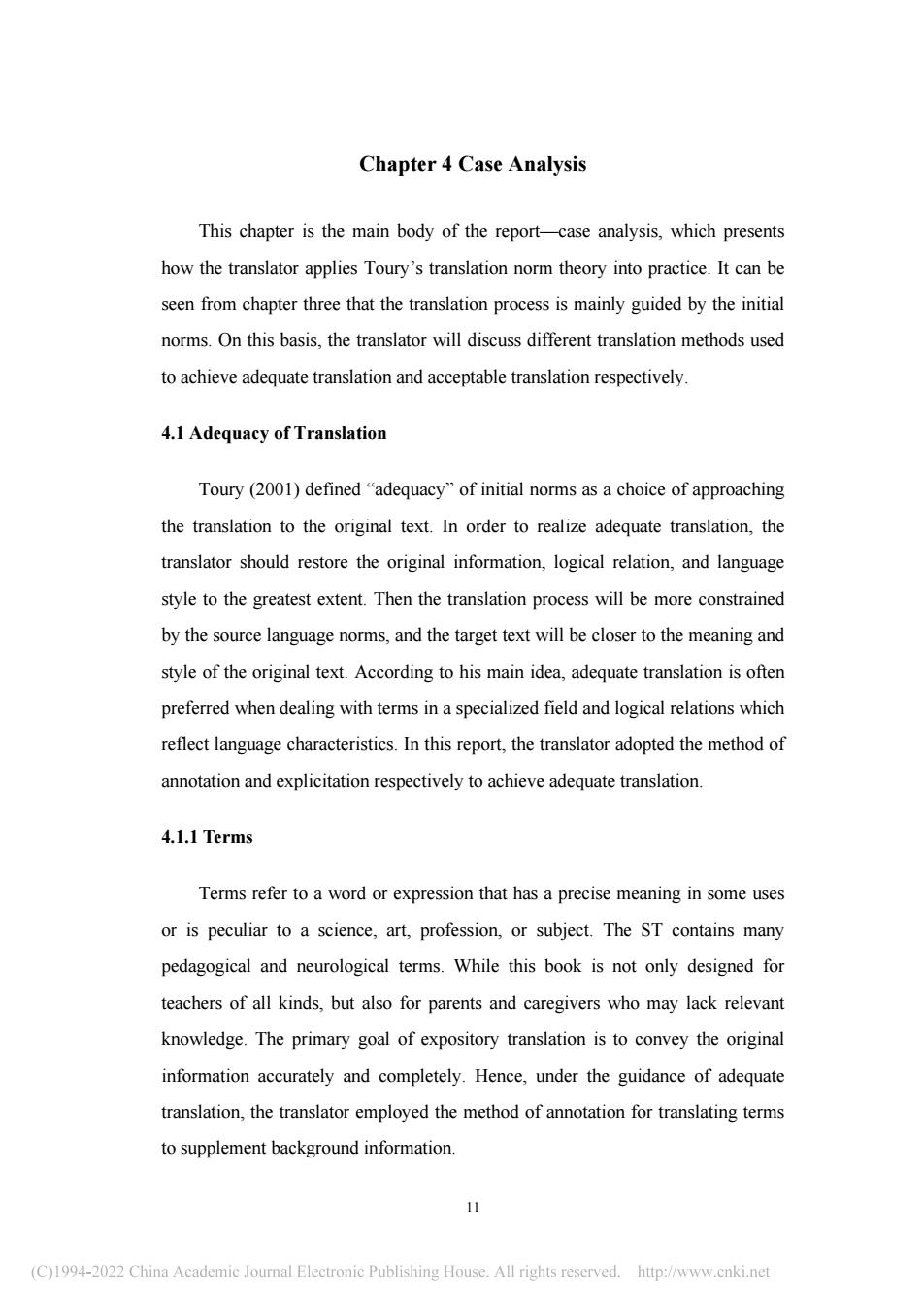
refers to not only social factors in a certain historical context,such as social needs and target readers,which influence translators'choice of ST,but also linguistic or cultural factors related to the text,such as its author,literary genre,and academic school.While the directness of translation means whether the translator chooses to translate ST through other languages,rather than directly from the source language to the target language(Toury,1995,p.57). Initial norms refer to the decision that a translator needs to make before translating.which is essential to the choice of overall translation strategy Specifically,the translator may be subject to the norms of the source text or target culture.If the translator chooses to follow the ST norms,he will strive to restore various elements in the original text,including language form and text structure That is called adequate translation.On the contrary,if the translator is more inclined to follow the language and cultural norms of the target language (TL),the translation aims to achieve its acceptability in the target-language environment which should be consistent with language conventions and socio-cultural background in the target language.It is named acceptable translation(Toury,2001, p.37). Liao (2009)described that"the translator's actual choices are restricted by operational norms during translating"(p.96).Operational norms determine the final expression of TT,the relationship between ST and TT,as well as consistency or variation during language conversion (Miao,2001,p.31).They can be subdivided into matricial norms and textual-linguistic norms.The so-called matrix represents ST itself.Matricial norms relate to the completeness and segmentation of TT.They determine the macro structure and form of TT,including the arrangement of text content,that is,whether to translate the whole text or several chapters and which part should be omitted or added(Schaffner,1999,p.65).While textual-linguistic norms mainly involve detailed principles that affect the language material of TT,which are reflected in word selection,sentence structure,and style. (C)1994-2022 China Academic Joural Electronie Publishing House.All rights reserved.http://www.enki.net
8 refers to not only social factors in a certain historical context, such as social needs and target readers, which influence translators’ choice of ST, but also linguistic or cultural factors related to the text, such as its author, literary genre, and academic school. While the directness of translation means whether the translator chooses to translate ST through other languages, rather than directly from the source language to the target language (Toury, 1995, p.57). Initial norms refer to the decision that a translator needs to make before translating, which is essential to the choice of overall translation strategy. Specifically, the translator may be subject to the norms of the source text or target culture. If the translator chooses to follow the ST norms, he will strive to restore various elements in the original text, including language form and text structure. That is called adequate translation. On the contrary, if the translator is more inclined to follow the language and cultural norms of the target language (TL), the translation aims to achieve its acceptability in the target-language environment, which should be consistent with language conventions and socio-cultural background in the target language. It is named acceptable translation (Toury, 2001, p.37). Liao (2009) described that “the translator’s actual choices are restricted by operational norms during translating” (p.96). Operational norms determine the final expression of TT, the relationship between ST and TT, as well as consistency or variation during language conversion (Miao, 2001, p.31). They can be subdivided into matricial norms and textual-linguistic norms. The so-called matrix represents ST itself. Matricial norms relate to the completeness and segmentation of TT. They determine the macro structure and form of TT, including the arrangement of text content, that is, whether to translate the whole text or several chapters and which part should be omitted or added (Schaffner, 1999, p.65). While textual-linguistic norms mainly involve detailed principles that affect the language material of TT, which are reflected in word selection, sentence structure, and style

3.2 Application of Translation Norm Theory in Expository Texts The expository text is intended to provide information about a topic with plain and accurate expressions,featured by certain illustrations,objective facts,and professional knowledge.It includes product instructions,operation manuals,work reports,guidebooks,and some non-literary texts.The translation of expository texts,neither like the literary translation that pursues the most natural and closest equivalence,nor like the translation of scientific and technological texts that focus on semantic equivalence,lies somewhere in between.When translating expository texts,the translator should pay attention to the ST itself,including its content and style.While language and cultural differences as well as the acceptability of target readers may also be taken into consideration.In order to convey information accurately and produce a fluent text,a translator can apply flexible methods to reorganize the TT without being restricted by the form of ST. Before the 1980s,translation studies were centered on the ST.Scholars assumed that a good translated version should be faithful,equivalent,and fluent to the ST(Wang.2013,p.5).While Toury shifted translation studies from a source language-oriented approach to a target language-oriented approach,which triggered the cultural turn in translation directly (Tang Sui Huang Wan Wu 2016,p.95).Since it was introduced into China,the translation norm theory established by Toury has not only been applied to guide the translation practices of literary texts but also expository texts,which can be proved by large amounts of translation reports and periodical articles.For example,it was once used to guide the translation of commercial expository texts which contain many terms and objective descriptions.To ensure the translation quality,most translators adopted translation strategies that combine domestication and foreignization,then came to the conclusion-abbreviations,terms and linguistic styles need to be translated under the guidance of"adequacy",while polysemies,set phrases,and complex sentences should be rendered under the guidance of"acceptability".The theory was also used to guide the translation of academic texts with rigorous logic 9 (C)1994-2022 China Academie Joumal Electronie Publishing House.All rights reserved.http://www.enki.net
9 3.2 Application of Translation Norm Theory in Expository Texts The expository text is intended to provide information about a topic with plain and accurate expressions, featured by certain illustrations, objective facts, and professional knowledge. It includes product instructions, operation manuals, work reports, guidebooks, and some non-literary texts. The translation of expository texts, neither like the literary translation that pursues the most natural and closest equivalence, nor like the translation of scientific and technological texts that focus on semantic equivalence, lies somewhere in between. When translating expository texts, the translator should pay attention to the ST itself, including its content and style. While language and cultural differences as well as the acceptability of target readers may also be taken into consideration. In order to convey information accurately and produce a fluent text, a translator can apply flexible methods to reorganize the TT without being restricted by the form of ST. Before the 1980s, translation studies were centered on the ST. Scholars assumed that a good translated version should be faithful, equivalent, and fluent to the ST (Wang, 2013, p.5). While Toury shifted translation studies from a source language-oriented approach to a target language-oriented approach, which triggered the cultural turn in translation directly (Tang Sui & Huang Wan Wu, 2016, p.95). Since it was introduced into China, the translation norm theory established by Toury has not only been applied to guide the translation practices of literary texts but also expository texts, which can be proved by large amounts of translation reports and periodical articles. For example, it was once used to guide the translation of commercial expository texts which contain many terms and objective descriptions. To ensure the translation quality, most translators adopted translation strategies that combine domestication and foreignization, then came to the conclusion—abbreviations, terms and linguistic styles need to be translated under the guidance of “adequacy”, while polysemies, set phrases, and complex sentences should be rendered under the guidance of “acceptability”. The theory was also used to guide the translation of academic texts with rigorous logic

accurate language,and clear structure.The translation strategies of translators were the integration of initial norms and operational norms.In terms of initial norms,the target texts may meet the requirements of adequacy and acceptability,that is to say they should cater to the writing habits and readers'preferences of the target language while reproducing the main information of the source text.In terms of operational norms,translation methods were summarized at the lexical,syntactic, and discourse levels,such as conversion,addition and voice changing Toury(1980)argued that the initial norms are the most important among the three types of norms,which reflect the overall translation tendency of a translator-adequacy or acceptability.However,he also pointed out that adequacy and acceptability are only two extremes at the theoretical level.In most translation practices,translators make a compromise between them.Based on the context and translation purpose,a translator tries his/her best to balance adequate translation and acceptable translation,which means the target text should not only reproduce the information function of source text but also be accepted by the target reader easily. The source text of this translation project belongs to an educational expository text characterized by rigorous structure,vivid explanation,and fluent expression When reading the ST,the translator encountered several difficulties,such as the translation of terms,common sayings,static expressions,and so on.In some cases, the translator needs to convey the information accurately and restore exotic cuture while in other cases,she should incline toward the target culture,presenting a translated version that is more acceptable to the target readers.Toury's translation norm theory is suitable to serve as the theoretical guidance of this project.Since the above-mentioned consideration of the translator eventually come down to the overall translation strategy of the source text,that is,the combination of"adequate translation"and"acceptable translation".In this report,the translator will mainly focus on the application of initial norms.The next chapter is a detailed presentation of the application of initial norms in this report with case analyses (C)1994-2022 China Academie Joumal Electronie Publishing House.All rights reserved.http://www.enki.net
10 accurate language, and clear structure. The translation strategies of translators were the integration of initial norms and operational norms. In terms of initial norms, the target texts may meet the requirements of adequacy and acceptability, that is to say, they should cater to the writing habits and readers’ preferences of the target language while reproducing the main information of the source text. In terms of operational norms, translation methods were summarized at the lexical, syntactic, and discourse levels, such as conversion, addition and voice changing. Toury (1980) argued that the initial norms are the most important among the three types of norms, which reflect the overall translation tendency of a translator—adequacy or acceptability. However, he also pointed out that adequacy and acceptability are only two extremes at the theoretical level. In most translation practices, translators make a compromise between them. Based on the context and translation purpose, a translator tries his/her best to balance adequate translation and acceptable translation, which means the target text should not only reproduce the information function of source text but also be accepted by the target reader easily. The source text of this translation project belongs to an educational expository text characterized by rigorous structure, vivid explanation, and fluent expression. When reading the ST, the translator encountered several difficulties, such as the translation of terms, common sayings, static expressions, and so on. In some cases, the translator needs to convey the information accurately and restore exotic culture; while in other cases, she should incline toward the target culture, presenting a translated version that is more acceptable to the target readers. Toury’s translation norm theory is suitable to serve as the theoretical guidance of this project. Since the above-mentioned consideration of the translator eventually come down to the overall translation strategy of the source text, that is, the combination of “adequate translation” and “acceptable translation”. In this report, the translator will mainly focus on the application of initial norms. The next chapter is a detailed presentation of the application of initial norms in this report with case analyses

Chapter 4 Case Analysis This chapter is the main body of the report-case analysis,which presents how the translator applies Toury's translation norm theory into practice.It can be seen from chapter three that the translation process is mainly guided by the initial norms.On this basis,the translator will discuss different translation methods used to achieve adequate translation and acceptable translation respectively. 4.1 Adequacy of Translation Toury (2001)defined"adequacy"of initial norms as a choice of approaching the translation to the original text.In order to realize adequate translation,the translator should restore the original information,logical relation,and language style to the greatest extent.Then the translation process will be more constrained by the source language norms,and the target text will be closer to the meaning and style of the original text.According to his main idea,adequate translation is often preferred when dealing with terms in a specialized field and logical relations which reflect language characteristics.In this report,the translator adopted the method of annotation and explicitation respectively to achieve adequate translation. 4.1.1Terms Terms refer to a word or expression that has a precise meaning in some uses or is peculiar to a science,art,profession,or subject.The ST contains many pedagogical and neurological terms.While this book is not only designed for teachers of all kinds,but also for parents and caregivers who may lack relevant knowledge.The primary goal of expository translation is to convey the original information accurately and completely.Hence,under the guidance of adequate translation,the translator employed the method of annotation for translating terms to supplement background information 11 (C)1994-2022 China Academie Joumal Electronie Publishing House.All rights reserved.http://www.enki.net
11 Chapter 4 Case Analysis This chapter is the main body of the report—case analysis, which presents how the translator applies Toury’s translation norm theory into practice. It can be seen from chapter three that the translation process is mainly guided by the initial norms. On this basis, the translator will discuss different translation methods used to achieve adequate translation and acceptable translation respectively. 4.1 Adequacy of Translation Toury (2001) defined “adequacy” of initial norms as a choice of approaching the translation to the original text. In order to realize adequate translation, the translator should restore the original information, logical relation, and language style to the greatest extent. Then the translation process will be more constrained by the source language norms, and the target text will be closer to the meaning and style of the original text. According to his main idea, adequate translation is often preferred when dealing with terms in a specialized field and logical relations which reflect language characteristics. In this report, the translator adopted the method of annotation and explicitation respectively to achieve adequate translation. 4.1.1 Terms Terms refer to a word or expression that has a precise meaning in some uses or is peculiar to a science, art, profession, or subject. The ST contains many pedagogical and neurological terms. While this book is not only designed for teachers of all kinds, but also for parents and caregivers who may lack relevant knowledge. The primary goal of expository translation is to convey the original information accurately and completely. Hence, under the guidance of adequate translation, the translator employed the method of annotation for translating terms to supplement background information

Example 1 ST:While all students benefit from a teacher-directed phonics approach,it is even more essential for those entering school with lesser reading ability.(Oakley et al,2021,p.48) TT:虽然所有学生都能从老师指导下的自然拼读法中获益,但对于入学 时阅读能力较差的学生而言,这一方法尤为重要。 译者注:自然拼读法,又称字母拼读法,是以英语为母语的欧美国家儿 童学习母语读音与拼字,增进阅读能力与理解力的教学法,主要教授内容为 英文字母与语音之间的对应关系。 Example 2 ST:This is why building students'prior knowledge in a given subject area is critical.(Oakley et al,2021,p.39) TT:这就是建立学生在特定学科领域内先验知识的重要性所在。 译者注:先验知识本义是哲学概念,指基于先天的认知形式,使经验成 为可能的知识。后引申到教育领域,指学习新知识前就己掌握的相关信息。 In these two examples,the underlined parts"phonics approach"and"prior knowledge"is unfamiliar to non-professional target readers.They may be obstacles when restoring the original information.Through online searching.the translator figured out that the"phonics approach"refers to a method of teaching children to read and write in English-spoken countries,while"prior knowledge"in the education field means the information and educational context a learner already has before they learn new information.Therefore,the translator added footnotes to explain these terms. 4.1.2 Implicit Logical Relation Toury (1995)stated the adequacy of translation is embodied in the pursuit of reproducing the relationship of the original text objectively in the target language without damaging the original linguistic structure.Reviewing the translation,the 12 (C)1994-2022 China Academie Joural Electronie Publishing House.All rights reserved.http://www.enki.net
12 Example 1 ST: While all students benefit from a teacher-directed phonics approach, it is even more essential for those entering school with lesser reading ability. (Oakley et al, 2021, p.48) TT: 虽然所有学生都能从老师指导下的自然拼读法中获益,但对于入学 时阅读能力较差的学生而言,这一方法尤为重要。 译者注:自然拼读法,又称字母拼读法,是以英语为母语的欧美国家儿 童学习母语读音与拼字,增进阅读能力与理解力的教学法,主要教授内容为 英文字母与语音之间的对应关系。 Example 2 ST: This is why building students’ prior knowledge in a given subject area is critical. (Oakley et al, 2021, p.39) TT: 这就是建立学生在特定学科领域内先验知识的重要性所在。 译者注:先验知识本义是哲学概念,指基于先天的认知形式,使经验成 为可能的知识。后引申到教育领域,指学习新知识前就已掌握的相关信息。 In these two examples, the underlined parts “phonics approach” and “prior knowledge” is unfamiliar to non-professional target readers. They may be obstacles when restoring the original information. Through online searching, the translator figured out that the “phonics approach” refers to a method of teaching children to read and write in English-spoken countries, while “prior knowledge” in the education field means the information and educational context a learner already has before they learn new information. Therefore, the translator added footnotes to explain these terms. 4.1.2 Implicit Logical Relation Toury (1995) stated the adequacy of translation is embodied in the pursuit of reproducing the relationship of the original text objectively in the target language without damaging the original linguistic structure. Reviewing the translation, the